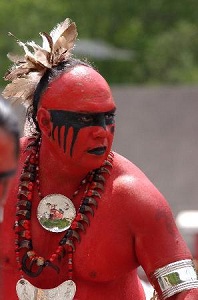Cherokee, North Carolina is synonymous with such word s as casinos, gambling, and resort town, but it wasn’t always like that. The now sprawling vacation spot was once as heavily forested as other parts of the Great Smoky Mountains National Park and once consisted of about 135,000 square miles of land owned by the Cherokee Indian Nation spread out over eight southern states.
The Cherokee Indian Reservation, also known as the Qualla Boundary, now only encompasses 56,000 of those acres. It’s also classified as sovereign land held in trust specifically for the Cherokee Indian tribe by the United States Government. The land was purchased by Will Thomas, who is not of Indian descent, in the late 1800s and was presented as a gift to the Cherokee people.
Over the past 100 years, thousands of non-Indians have moved into the area and developed the region, though it’s still home to the Cherokee. The tourism industry makes up about 75 percent of the tribe’s revenues – the mainstay of their economy. Cherokee businesses hold “trader’s licenses” and collect a six percent tribal levy on sales.
The Indians that currently live in Cherokee are a part of the Eastern Band of Cherokee Indians. They are descendants of the Cherokee Indians who hid in the Great Smoky Mountains to avoid forced removal to Oklahoma on the infamous “Trail of Tears” during the late 1830s.
Cherokee’s tourism boom, as previously mentioned, exploded in the late 1940s, around the same time the Great Smoky Mountains were designated as a national park. The Blue Ridge Parkway was also in the early stages of development. As the park opened and construction on the parkway got underway, two highways were bringing out-of-towners into Cherokee – US 441 and US 19, and assistance to support the influx of visitors was imperative.
The businesses and services that developed out of the construction of these roads played a large part in Cherokee’s formation as an incorporated town. Today, the assumption that the Qualla Boundary and its businesses are Indian-owned is for the most part still true but, by the authority of the Tribal Council; Indians are allowed to lease their businesses or buildings to non-Indians. The Cherokee people rightfully can continue to claim the status of “original inhabitants” of the vast and beautiful Smoky Mountains, even as the Reservation continues to grow and develop.
Still, whenever Cherokee is brought up, people have a tendency to delve into the history of the Cherokee Indians and the way they have been treated over the years, especially by the U.S. government. You can speak with a number of people with a slew of different titles that say the Cherokee removal might have been avoided, if the U.S. government had played a different role in the beginning, and if English settlers had tried a more peaceable approach to living with the Cherokee.
The Cherokee enjoyed a pretty high quality of life up to the early 1800s. They basically governed themselves and their many communities through their own form of government. Sequoyah, one of the Cherokee’s most prominent leaders, spent 12 years developing the Cherokee Alphabet and he was never able to read or write another language – he is the only known person to be able to carry out such a feat.
Generations of Cherokees have been told the story of how their ancestors were removed from their homelands. Numerous books have been penned and films made about the subject. Two outdoor dramas have been made as well – “Unto These Hills,” which has played to four decades of audiences in Cherokee, N.C. and “Trail of Tears,” which is performed annually in Tahlequah, Oklahoma. There is no doubt that the designation of the Trail of Tears as a national landmark has enhanced awareness of the tragedy. The designation of the trail as a national landmark was the culmination of four years of planning on the part of the Eastern and Western Cherokee Tribes, the National Park Service and several states “to protect and identify the historic route, artifacts and remnants for enjoyment and public use.” A comprehensive management plan was developed by a 35-member advisory council. From Cherokee, NC, to Tahlequah, Oklahoma, a trail logo was adopted and placed along the extending land and water route. Interpretive centers have been planned for each state the trail passes through – North Carolina, Alabama, Tennessee, Georgia, Missouri, Arkansas, Illinois, and Oklahoma – with state, local, and federal governments participating.
